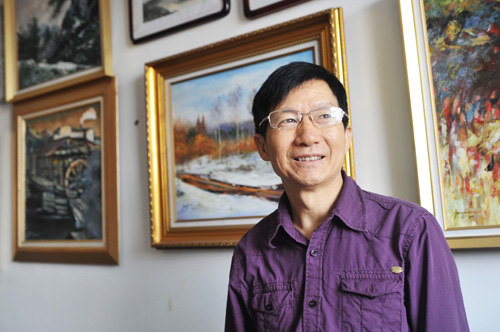|
 |
|
Huang Jiannan (COURTESY OF HUANG JIANNAN) |
Huang Jiannan, 60, has garnered fame both in and outside of China in recent years with his unique oil paintings. His work is routinely praised by the art community and his pieces sold at high prices.
In September of last year, Huang's color ink painting The Loop of Nature was displayed and collected by the gallery Carrousel du Louvre in Paris. Michel King, an artist and Vice Chairman of Société Nationale des Beaux-Arts—the national artists association of France, commented that Huang's paintings have shifted his view of Chinese art. "When I see Chinese paintings, I often have an impression that 50 painters paint the same as a single painter paints, and today's paintings are like the artworks of five centuries ago. But today I found a unique Chinese painting. [Huang's color ink painting] has different characteristics, changing my 50-year-long opinion about Chinese painting."
Huang is skilled at painting landscapes. He has a propensity for bright colors in his works and combines the techniques of traditional ink painting with Western-featured oil painting, shaping his pieces in a style that is distinctively his own.
"Most of my paintings are landscape-themed," said Huang. "This is because I love nature very much. Green mountains and clear rivers surround my hometown. The human and natural elements are themselves a beautiful painting. I get a precious and familiar feeling of comfort and peace from beautiful scenery."
Huang's career in art was not guaranteed from the beginning. In 1952, Huang was born in a small village in Heyuan County, south China's Guangdong Province. From his childhood, Huang took a firm interest in painting, and at the age of 12 he began to paint without a teacher. Despite not having received a formal art education, Huang soon mastered the skills of painting and using color. A lifelong dedication to painting was born.
Beginning as an apprentice, he was tasked with painting pictures on furniture, windows and doors. After graduating from high school in 1970, Huang earned a living traveling around China as a painter, having walked thousands of miles from Guangdong Province to northeast Heilongjiang Province. From theater stage to window glass to traditional Chinese art, Huang tried his hand at a variety of painting forms.
In the fall of 1977, Huang paid a visit to Guan Shanyue (1912-2000), a prominent artist of south China ink painting. After gazing at Huang's oil paintings, Guan said to the young man, "Your painting is blended with the soul of Chinese painting."
Under the encouragement and guidance of the painting master, Huang further developed his artistic direction: landscape oil painting combining realistic and freestyle elements.
Huang became torn and irresolute in the 1980s, a time when the Chinese society was undergoing massive economic change. Shenzhen was a frontier of opening up and reform. Paintings and other artworks became goods at markets and shops. Artists no longer had to be poor and were able to greatly profit from their talents. Huang moved to Shenzhen and established his painting business and soon became rich. But, money didn't bring happiness.
"When art becomes commodity, it is no longer art. Because in markets, art has to depend on the interests of consumers in order to be profitable. Artists will lose their liberty in creating art that isn't driven by commercial demands. People usually don't care for real art, especially experimental artwork. Besides, fakes soon became rampant in the market."
Art to live or live for art? That, for Huang, was the question. Huang desired to once again be a true artist rather than a commercial art maker. He left Shenzhen years later but not before having infused his own artistic palette with various oil painting works, from impressionism to realism, from cubism to modern art. Huang was enlightened from so many fine arts. He absorbed art like food and created his own unique style.
After leaving Shenzhen, Huang again set off to travel, this time hoping to find inspiration from the world's natural beauty. He traveled across China once more, drawing inspiration from the country's mountains and bodies of water. He called New Zealand home for two years and thought deeply about ancient and modern art. Travel enriched Huang's experience and brought him much spiritual wealth, which laid the foundation for his later work.
The year 2003 proved particularly prodigious for Huang. Having returned from nature, Huang created a copious number of landscape paintings that won awards and praise. At the invitation of the Beijing-based Chinese Painting and Calligraphy Institute, Huang assumed the office of vice president. Living in the capital, Huang attended a lot of exhibitions and international cultural events, receiving wide recognition for his work.
In December of 2008, Huang held a solo exhibition in Bangkok where his paintings attracted the attention of the local elite, including Princess Maha Chakri Sirindhorn. The princess described Huang's paintings as having an "Eastern charm." In order to enhance the friendship between China and Thailand, Huang donated his paintings to charities in Thailand.
For Huang, success isn't born out of pure luck.
"If an artist simply mimics the work of great masters, his own artwork will simply be a repeat. The nature of art is to be original and creative. But this talent must be based on hard work and persistence."
| 